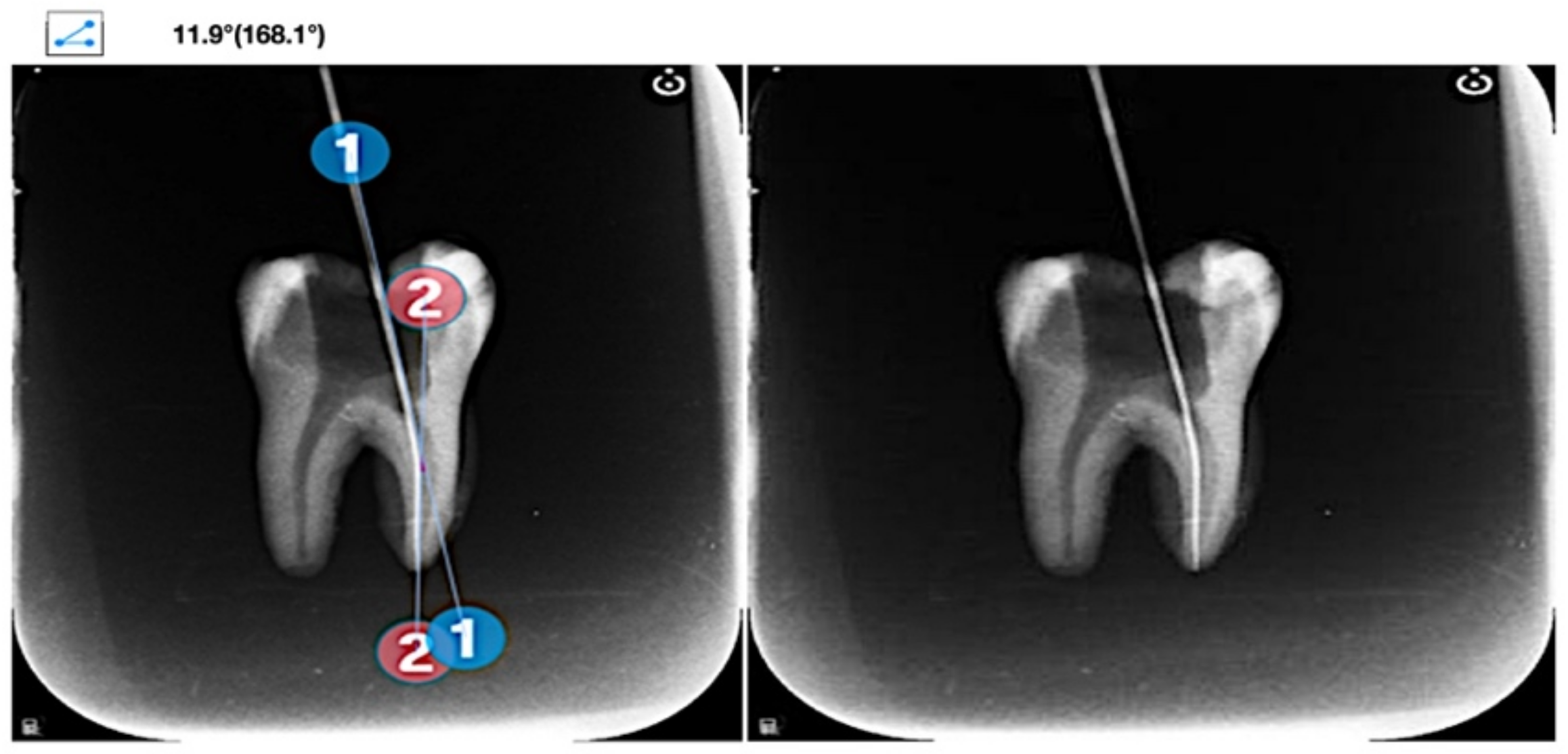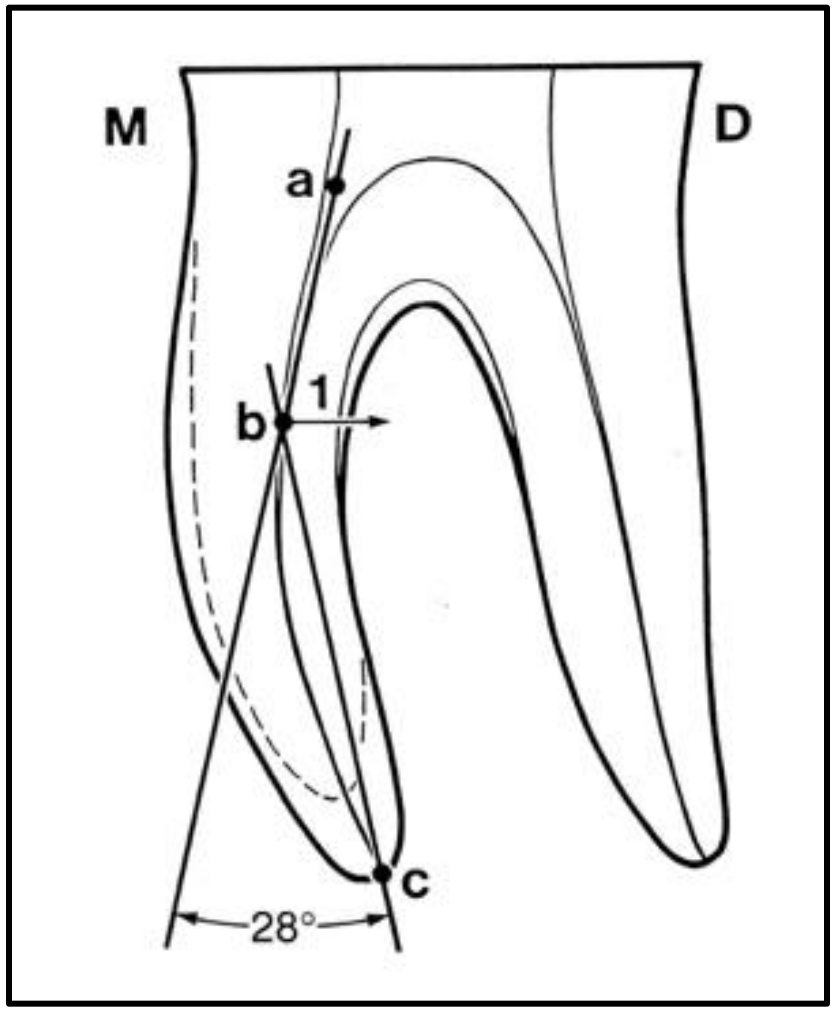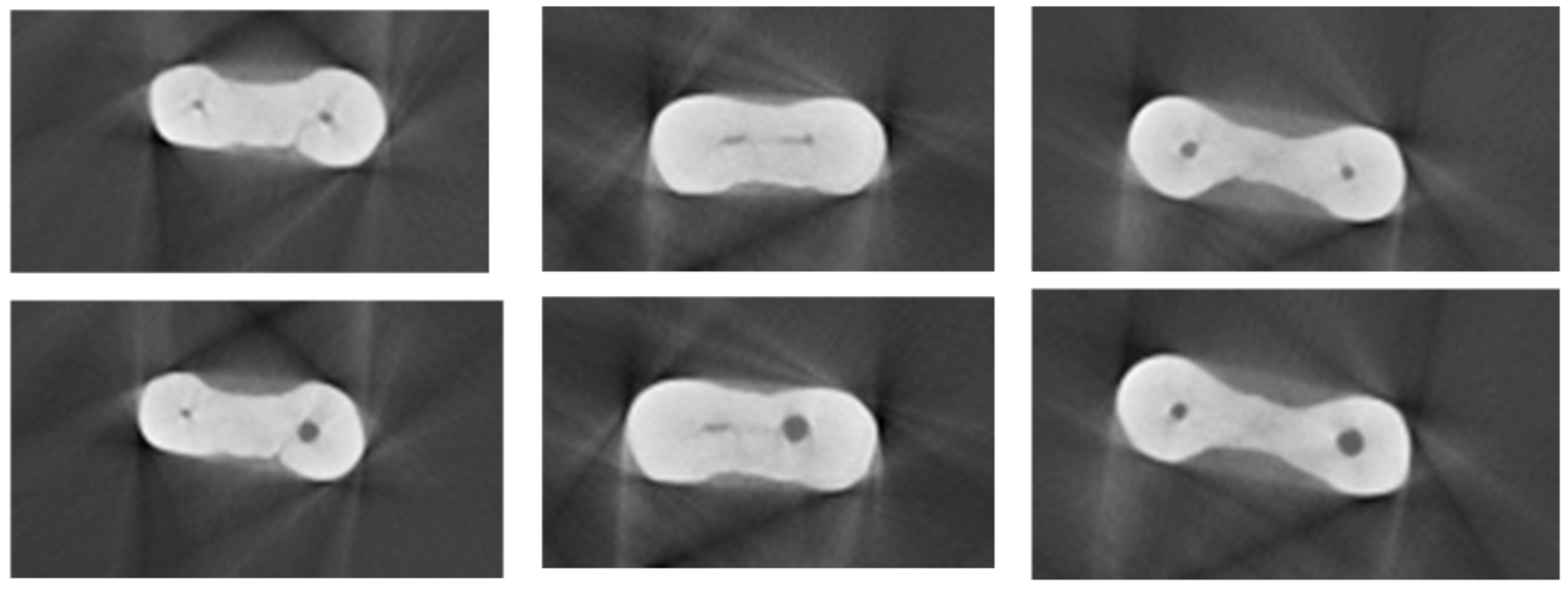Micro-Computed Tomographic Assessment of Microcrack Formation before and after Instrumentation of Curved Root Canals with Neoniti Rotary Files
Abstract
1. Introduction
2. Materials and Methods
3. Results
4. Discussion
5. Conclusions
Author Contributions
Funding
Institutional Review Board Statement
Informed Consent Statement
Conflicts of Interest
References
- Stringheta, C.P.; Bueno, C.E.S.; Kato, A.S.; Freire, L.G.; Iglecias, E.F.; Santos, M.; Pelegrine, R.A. Micro-computed tomographic evaluation of the shaping ability of four instrumentation systems in curved root canals. Int. Endod. J. 2019, 52, 908–916. [Google Scholar] [CrossRef] [PubMed]
- De-Deus, G.; César de Azevedo Carvalhal, J.; Belladonna, F.G.; Silva, E.J.N.L.; Lopes, R.T.; Moreira Filho, R.E.; Souza, E.M.; Provenzano, J.C.; Versiani, M.A. Dentinal Microcrack Development after Canal Preparation: A Longitudinal in Situ Micro-computed Tomography Study Using a Cadaver Model. J. Endod. 2017, 43, 1553–1558. [Google Scholar] [CrossRef] [PubMed]
- Yoshino, K.; Ito, K.; Kuroda, M.; Sugihara, N. Prevalence of vertical root fracture as the reason for tooth extraction in dental clinics. Clin. Oral Investig. 2015, 19, 1405–1409. [Google Scholar] [CrossRef] [PubMed]
- Petersen, K.B. Longitudinal root fracture due to corrosion of an endodontic post. J. Can. Dent. Assoc. 1971, 37, 66–68. [Google Scholar] [PubMed]
- Pitts, D.L.; Matheny, H.E.; Nicholls, J.I. An in vitro study of spreader loads required to cause vertical root fracture during lateral condensation. J. Endod. 1983, 9, 544–550. [Google Scholar] [CrossRef]
- Obermayr, G.; Walton, R.E.; Leary, J.M.; Krell, K.V. Vertical root fracture and relative deformation during obturation and post cementation. J. Prosthet. Dent. 1991, 66, 181–187. [Google Scholar] [CrossRef]
- Versiani, M.; Souza, E.; De-Deus, G. Critical appraisal of studies on dentinal radicular microcracks in endodontics: Methodological issues, contemporary concepts, and future perspectives. Endod. Top. 2015, 33, 87–156. [Google Scholar] [CrossRef]
- Yoldas, O.; Yilmaz, S.; Atakan, G.; Kuden, C.; Kasan, Z. Dentinal microcrack formation during root canal preparations by different NiTi rotary instruments and the self-adjusting file. J. Endod. 2012, 38, 232–235. [Google Scholar] [CrossRef]
- Ceyhanli, K.T.; Erdilek, N.; Tatar, I.; Celik, D.A. Comparison of ProTaper, RaCe and Safesider instruments in the induction of dentinal microcracks: A micro-CT study. Int. Endod. J. 2016, 49, 684–689. [Google Scholar] [CrossRef]
- Adorno, C.G.; Yoshioka, T.; Suda, H. The effect of root preparation technique and instrumentation length on the development of apical root cracks. J. Endod. 2009, 35, 389–392. [Google Scholar] [CrossRef]
- Mokhtari, H.; Niknami, M.; Sohrabi, A.; Habibivand, E.; Zonouzi, H.R.; Rahimi, S.; Zand, V. Cone-beam computed tomography comparison of canal transportation after preparation with BioRaCe and Mtwo rotary instruments and hand K-Flexofiles. Iran. Endod. J. 2014, 9, 180–184. [Google Scholar]
- Mavani, P.; Pujar, M.; Uppin, V.; Vagarali, H.; Patil, C.; Yalagi, V. Comparative evaluation of root cracks by different rotary and reciprocating endodontic file systems. IOSR J. Dent. Med. Sci. 2015, 14, 18–22. [Google Scholar]
- Pasqualini, D.; Alovisi, M.; Cemenasco, A.; Mancini, L.; Paolino, D.S.; Bianchi, C.C.; Roggia, A.; Scotti, N.; Berutti, E. Micro-Computed Tomography Evaluation of ProTaper Next and BioRace Shaping Outcomes in Maxillary First Molar Curved Canals. J. Endod. 2015, 41, 1706–1710. [Google Scholar] [CrossRef]
- Çitak, M.; Özyürek, T. Effect of different nickel-titanium rotary files on dentinal crack formation during retreatment procedure. J. Dent. Res. Dent. Clin. Dent. Prospect. 2017, 11, 90–95. [Google Scholar] [CrossRef]
- Pop, I.; Manoharan, A.; Zanini, F.; Tromba, G.; Patel, S.; Foschi, F. Synchrotron light-based μCT to analyse the presence of dentinal microcracks post-rotary and reciprocating NiTi instrumentation. Clin. Oral Investig. 2015, 19, 11–16. [Google Scholar] [CrossRef]
- Kim, H.C.; Lee, M.H.; Yum, J.; Versluis, A.; Lee, C.J.; Kim, B.M. Potential relationship between design of nickel-titanium rotary instruments and vertical root fracture. J. Endod. 2010, 36, 1195–1199. [Google Scholar] [CrossRef]
- Ruddle, C.J.; Machtou, P.; West, J.D. The shaping movement: Fifth-generation technology. Dent. Today 2013, 32, 94–99. [Google Scholar]
- Kuzekanani, M. Nickel-Titanium Rotary Instruments: Development of the Single-File Systems. J. Int. Soc. Prev. Commu. Dent. 2018, 8, 386–390. [Google Scholar] [CrossRef]
- Forghani, M.; Hezarjaribi, M.; Teimouri, H. Comparison of the shaping characteristics of Neolix and Protaper Universal systems in preparation of severely-curved simulated canals. J. Clin. Exp. Dent. 2017, 9, e556–e559. [Google Scholar] [CrossRef][Green Version]
- Silva, E.J.N.L.; Martins, J.N.R.; Lima, C.O.; Vieira, V.T.L.; Braz Fernandes, F.M.; De-Deus, G.; Versiani, M.A. Mechanical Tests, Metallurgical Characterization, and Shaping Ability of Nickel-Titanium Rotary Instruments: A Multimethod Research. J. Endod. 2020, 46, 1485–1494. [Google Scholar] [CrossRef]
- Cassimiro, M.; Romeiro, K.; Gominho, L.; de Almeida, A.; Costa, L.; Albuquerque, D. Occurence of dentinal defects after root canal preparation with R-phase, M-Wire and Gold Wire instruments: A micro-CT analysis. BMC Oral Health 2017, 17, 93. [Google Scholar] [CrossRef]
- Hashem, A.A.; Ghoneim, A.G.; Lutfy, R.A.; Foda, M.Y.; Omar, G.A. Geometric analysis of root canals prepared by four rotary NiTi shaping systems. J. Endod. 2012, 38, 996–1000. [Google Scholar] [CrossRef]
- Gundappa, M.; Bansal, R.; Khoriya, S.; Mohan, R. Root canal centering ability of rotary cutting nickel titanium instruments: A meta-analysis. J. Conserv. Dent. JCD 2014, 17, 504–509. [Google Scholar] [CrossRef]
- Kishore, A.; Gurtu, A.; Bansal, R.; Singhal, A.; Mohan, S.; Mehrotra, A. Comparison of canal transportation and centering ability of Twisted Files, HyFlex controlled memory, and Wave One using computed tomography scan: An in vitro study. J. Conserv. Dent. JCD 2017, 20, 161–165. [Google Scholar] [CrossRef]
- Loizides, A.L.; Kakavetsos, V.D.; Tzanetakis, G.N.; Kontakiotis, E.G.; Eliades, G. A comparative study of the effects of two nickel-titanium preparation techniques on root canal geometry assessed by microcomputed tomography. J. Endod. 2007, 33, 1455–1459. [Google Scholar] [CrossRef]
- De-Deus, G.; Belladonna, F.G.; Souza, E.M.; Silva, E.J.; de Almeida Neves, A.; Alves, H.; Lopes, R.T.; Versiani, M.A. Micro-computed tomographic assessment on the effect of ProTaper Next and Twisted File Adaptive systems on dentinal cracks. J. Endod. 2015, 41, 1116–1119. [Google Scholar] [CrossRef]
- De-Deus, G.; Silva, E.J.; Marins, J.; Souza, E.; de Almeida Neves, A.; Belladonna, F.G.; Alves, H.; Lopes, R.T.; Versiani, M.A. Lack of causal relationship between dentinal microcracks and root canal preparation with reciprocation systems. J. Endod. 2014, 40, 1447–1450. [Google Scholar] [CrossRef]
- De-Deus, G.; Belladonna, F.G.; Silva, E.J.; Souza, E.M.; Versiani, M.A. Critical appraisal of some methodological aspects of using micro-CT technology in the study of dentinal microcracks in endodontics. Int. Endod. J. 2016, 49, 216–219. [Google Scholar] [CrossRef]
- Schneider, S.W. A comparison of canal preparations in straight and curved root canals. Oral Sur. Oral Med. Oral Pathol. 1971, 32, 271–275. [Google Scholar] [CrossRef]
- Miguéns-Vila, R.; Martín-Biedma, B.; De-Deus, G.; Belladonna, F.; Peña-López, A.; Castelo-Baz, P. Micro-computed tomography evaluation of dentinal micro-cracks after preparation of curved root canals with ProTaper Gold, WaveOne Gold and ProTaper NEXT instruments. J. Endod. 2021, 47, 309–314. [Google Scholar] [CrossRef]
- Bayram, H.M.; Bayram, E.; Ocak, M.; Uygun, A.D.; Celik, H.H. Effect of ProTaper Gold, Self-Adjusting File, and XP-endo Shaper instruments on dentinal microcrack formation: A micro-computed tomographic study. J. Endod. 2017, 43, 1166–1169. [Google Scholar] [CrossRef] [PubMed]
- Mohamed, R.; Majid, S.; Faiza, A. Root Microcracks Formation during Root Canal Instrumentation Using Reciprocating and Rotary Files. J. Contemp. Dent. Pract. 2021, 22, 259–263. [Google Scholar] [CrossRef] [PubMed]
- Silva, R.V.; Alcalde, M.P.; Horta, M.C.; Rodrigues, C.T.; Silveira, F.F.; Duarte, M.A.; Nunes, E. Root canal shaping of curved canals by Reciproc Blue system and Pro Taper Gold: A micro-computed tomographic study. J. Clin. Exp. Dent. 2021, 13, e112–e118. [Google Scholar] [CrossRef] [PubMed]
- Mandava, J.; Yelisela, R.K.; Arikatla, S.K.; Ravi, R.C. Micro-computed tomographic evaluation of dentinal defects after root canal preparation with hyflex edm and vortex blue rotary systems. J. Clin. Exp. Dent. 2018, 10, e844–e851. [Google Scholar] [CrossRef]
- Khoshbin, E.; Donyavi, Z.; Atibeh, E.A.; Roshanaei, G.; Amani, F. The effect of canal preparation with four different rotary systems on formation of dentinal cracks: An in vitro evaluation. Iran. Endod. J. 2018, 13, 163–168. [Google Scholar]
- Tomer, A.K.; Sahni, S.; Goud, B.V.; Pyasi, S.K.; Bhatt, M. Comparative Evaluation Of Dentinal Defects Caused By Different Rotary Ni-Ti Instruments-A In Vitro Study. Int. J. Innov. Res. Adv. Stud. (IJIRAS) 2018, 5, 200–203. [Google Scholar]
- Khoshbin, E.; Shokri, A.; Donyavi, Z.; Shahriari, S.; Salehimehr, G.; Farhadian, M.; Kavandi, Z. Comparison of the root canal debridement ability of two single file systems with a conventional multiple rotary system in long oval-shaped root canals: In vitro study. J. Clin. Exp. Dent. 2017, 9, e939–e944. [Google Scholar] [CrossRef][Green Version]
- Kim, H.C.; Sung, S.Y.; Ha, J.H.; Solomonov, M.; Lee, J.M.; Lee, C.J.; Kim, B.M. Stress generation during self-adjusting file movement: Minimally invasive instrumentation. J. Endod. 2013, 39, 1572–1575. [Google Scholar] [CrossRef]
- Bier, C.A.; Shemesh, H.; Tanomaru-Filho, M.; Wesselink, P.R.; Wu, M.K. The ability of different nickel-titanium rotary instruments to induce dentinal damage during canal preparation. J. Endod. 2009, 35, 236–238. [Google Scholar] [CrossRef]
- Liu, R.; Hou, B.X.; Wesselink, P.R.; Wu, M.K.; Shemesh, H. The incidence of root microcracks caused by 3 different single-file systems versus the ProTaper system. J. Endod. 2013, 39, 1054–1056. [Google Scholar] [CrossRef]
- Harandi, A.; Mirzaeerad, S.; Mehrabani, M.; Mahmoudi, E.; Bijani, A. Incidence of dentinal crack after root canal preparation by ProTaper universal, Neolix and SafeSider systems. Iran. Endod. J. 2017, 12, 432–438. [Google Scholar]
- Bürklein, S.; Hinschitza, K.; Dammaschke, T.; Schäfer, E. Shaping ability and cleaning effectiveness of two single-file systems in severely curved root canals of extracted teeth: Reciproc and WaveOne versus Mtwo and ProTaper. Int. Endod. J. 2012, 45, 449–461. [Google Scholar] [CrossRef]
- Zhang, R.; Hu, T. Root canal curvature. Int. Endod. J. 2010, 43, 616–618. [Google Scholar] [CrossRef]
- Shemesh, H.; Roeleveld, A.C.; Wesselink, P.R.; Wu, M.K. Damage to root dentin during retreatment procedures. J. Endod. 2011, 37, 63–66. [Google Scholar] [CrossRef]
- Shemesh, H.; Bier, C.A.; Wu, M.K.; Tanomaru-Filho, M.; Wesselink, P.R. The effects of canal preparation and filling on the incidence of dentinal defects. Int. Endod. J. 2009, 42, 208–213. [Google Scholar] [CrossRef]




| Time of Measurement | Minimum | Maximum | Mean | Std. Deviation |
|---|---|---|---|---|
| Preoperatively | 0.00 | 18.52 | 7.40 | 8.02 |
| Postoperatively | 0.00 | 25.93 | 11.59 | 9.74 |
| Time of Measurement | Minimum | Maximum | Mean | Std. Deviation |
|---|---|---|---|---|
| Preoperatively | 0.00 | 16.67 | 7.20 | 5.94 |
| Postoperatively | 6.67 | 23.33 | 13.23 | 5.64 |
Publisher’s Note: MDPI stays neutral with regard to jurisdictional claims in published maps and institutional affiliations. |
© 2022 by the authors. Licensee MDPI, Basel, Switzerland. This article is an open access article distributed under the terms and conditions of the Creative Commons Attribution (CC BY) license (https://creativecommons.org/licenses/by/4.0/).
Share and Cite
Zarean, P.; Özcan, M.; Zarean, P.; Haghani, S.O.; Jahromi, M.Z.; Al-Haj Husain, N.; Khabiri, M. Micro-Computed Tomographic Assessment of Microcrack Formation before and after Instrumentation of Curved Root Canals with Neoniti Rotary Files. Materials 2022, 15, 3002. https://doi.org/10.3390/ma15093002
Zarean P, Özcan M, Zarean P, Haghani SO, Jahromi MZ, Al-Haj Husain N, Khabiri M. Micro-Computed Tomographic Assessment of Microcrack Formation before and after Instrumentation of Curved Root Canals with Neoniti Rotary Files. Materials. 2022; 15(9):3002. https://doi.org/10.3390/ma15093002
Chicago/Turabian StyleZarean, Parichehr, Mutlu Özcan, Paridokht Zarean, Seyed Omid Haghani, Maryam Zare Jahromi, Nadin Al-Haj Husain, and Masoud Khabiri. 2022. "Micro-Computed Tomographic Assessment of Microcrack Formation before and after Instrumentation of Curved Root Canals with Neoniti Rotary Files" Materials 15, no. 9: 3002. https://doi.org/10.3390/ma15093002
APA StyleZarean, P., Özcan, M., Zarean, P., Haghani, S. O., Jahromi, M. Z., Al-Haj Husain, N., & Khabiri, M. (2022). Micro-Computed Tomographic Assessment of Microcrack Formation before and after Instrumentation of Curved Root Canals with Neoniti Rotary Files. Materials, 15(9), 3002. https://doi.org/10.3390/ma15093002







